Cycling to Durgadi Fort and Khidkaleshwar Temple in Kalyan
With a trek planned on Sunday, I still wanted to do a cycling trip somewhere so as to not lose steam in my quest to cover all the forts in Mumbai and Thane region. Also, with a knee that I injured in my mountain biking in Germany, I wanted to avoid any off road cycling for a while. So I chose a place from my forts list that was reachable by normal road – Durgadi Fort in Kalyan.
To reach the fort, I rode along the Eastern Express Highway via Thane, then turned towards Kalyan on the old Agra Road. This road crosses the Ulhas river near Ganesh ghat. There are two bridges across the river. The new one is on the left, and the old bridge towards the right, which is not motorable, but one can walk or cycle across. The fort is located on the other side of the bridge along the river coast.
The fort has an interesting history. In the 17th century during the moghul reign, the city of Kalyan was surrounded by a fort wall. This city wall was guarded by 4 gates and 11 towers. Within the fort wall on a high mound near the Kalyan creek that is currently called Ganesh ghat, stood Durgadi Fort.
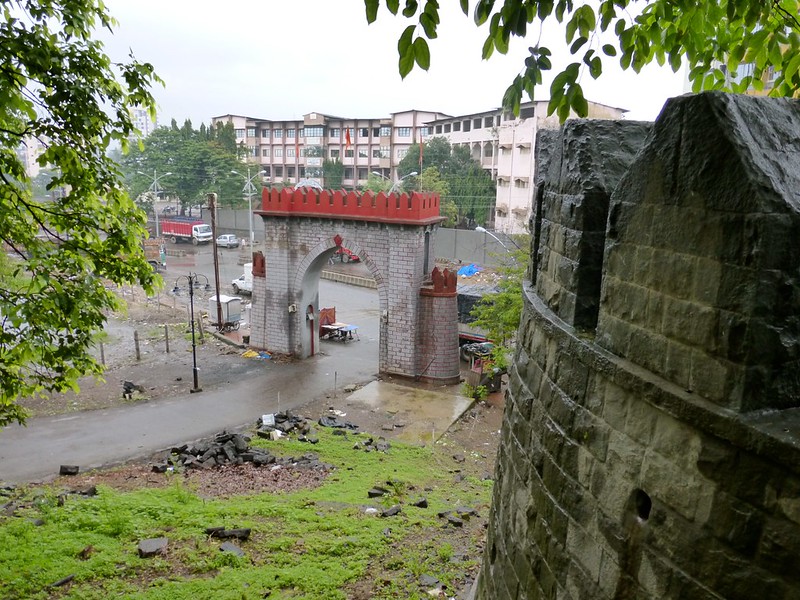 The original gate of the fort was near the north end, and was called the Delhi Darwaja. When the Marathas took over the fort in the 18th century, a new gate was built to the south of the fort for easy access from the Peshwa’s mansion.
The original gate of the fort was near the north end, and was called the Delhi Darwaja. When the Marathas took over the fort in the 18th century, a new gate was built to the south of the fort for easy access from the Peshwa’s mansion.
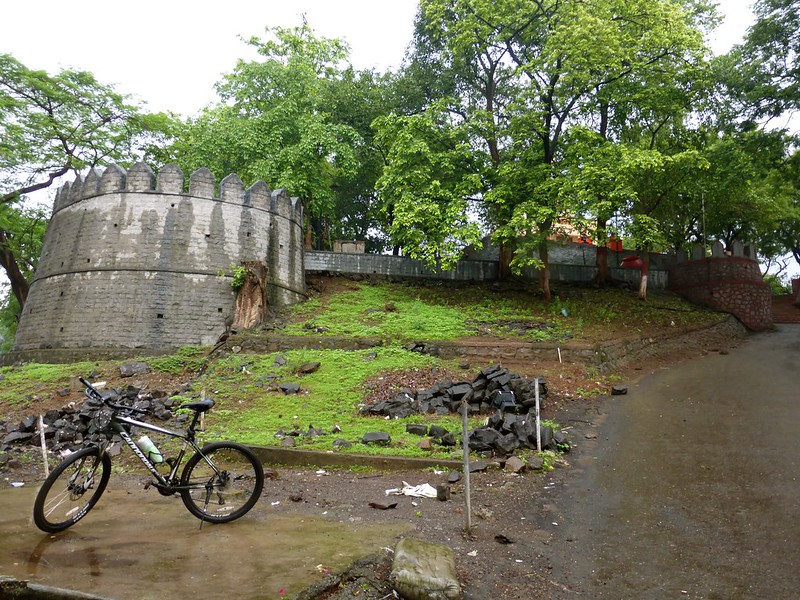 As you enter the main gate, you can see the fort on a small hillock, covered with lots of trees forming a canopy over it
As you enter the main gate, you can see the fort on a small hillock, covered with lots of trees forming a canopy over it
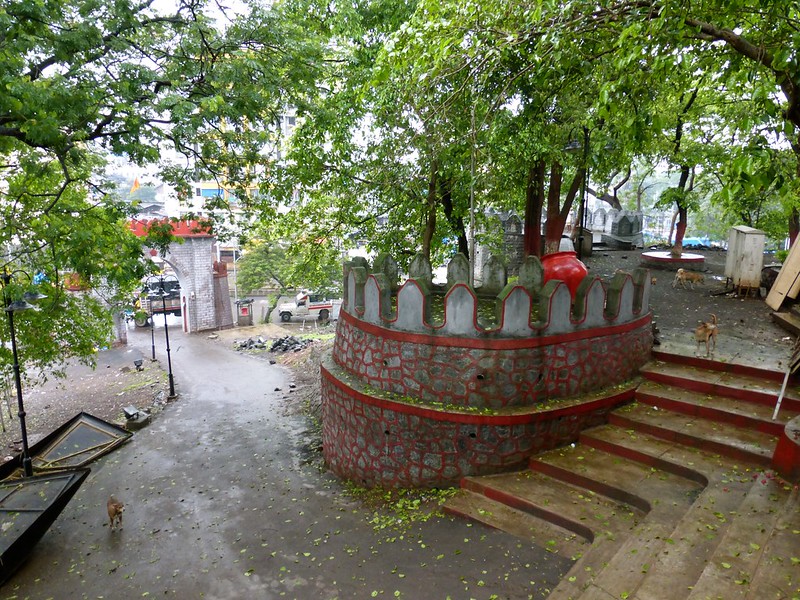 A short sloping road takes you up the hill to the entrance of the fort, where L shaped stairs lead you to the lower level of the fort. To the left, you can walk over to the bastions on the south, and straight to the right is the entrance to the temple
A short sloping road takes you up the hill to the entrance of the fort, where L shaped stairs lead you to the lower level of the fort. To the left, you can walk over to the bastions on the south, and straight to the right is the entrance to the temple
 The steps to the right lead to this platform that is maintained by the temple authorities. For I reached early in the morning, the staff was in the process of sweeping and cleaning the place
The steps to the right lead to this platform that is maintained by the temple authorities. For I reached early in the morning, the staff was in the process of sweeping and cleaning the place
 Further steps lead up to the temple on the higher level of the fort. The Durga temple was built by the Marathas. It was originally built as a wooden temple and has been renovated into a brick and mortar structure by the Kalyan municipality.
Further steps lead up to the temple on the higher level of the fort. The Durga temple was built by the Marathas. It was originally built as a wooden temple and has been renovated into a brick and mortar structure by the Kalyan municipality.
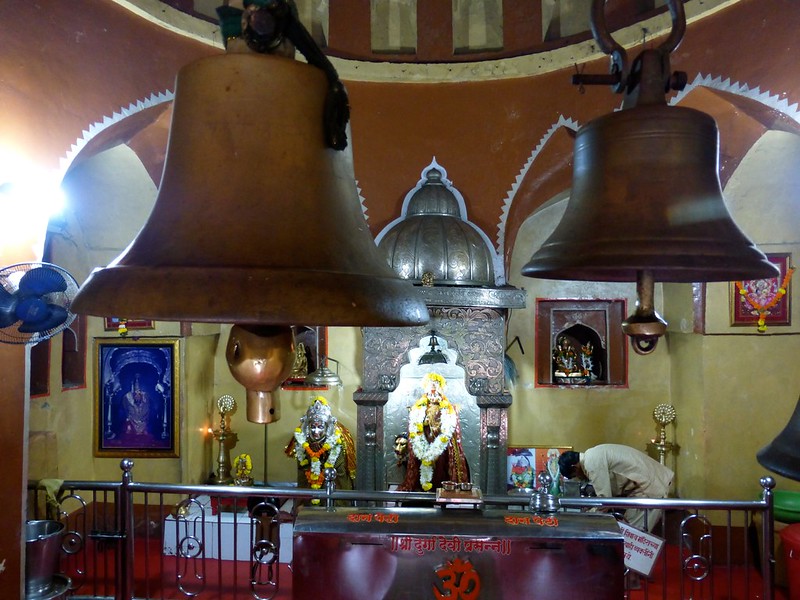 In 1876, the original Durga idol from the temple was stolen. A new idol made out of 5 sacred metals – called panchadhatu – was installed by Shri Gajanan Maharaj and Shri Annasaheb Pattekar of Thane.
In 1876, the original Durga idol from the temple was stolen. A new idol made out of 5 sacred metals – called panchadhatu – was installed by Shri Gajanan Maharaj and Shri Annasaheb Pattekar of Thane.
 In the Durga temple, in one corner lies a huge drum that is about 4 feet in diameter. It is played during the prayers or aartis. I was fortunate to catch the first aarti of the day at 7 am, and got a chance to play this huge drum. The sound of the drum reverberates through the entire temple.
In the Durga temple, in one corner lies a huge drum that is about 4 feet in diameter. It is played during the prayers or aartis. I was fortunate to catch the first aarti of the day at 7 am, and got a chance to play this huge drum. The sound of the drum reverberates through the entire temple.
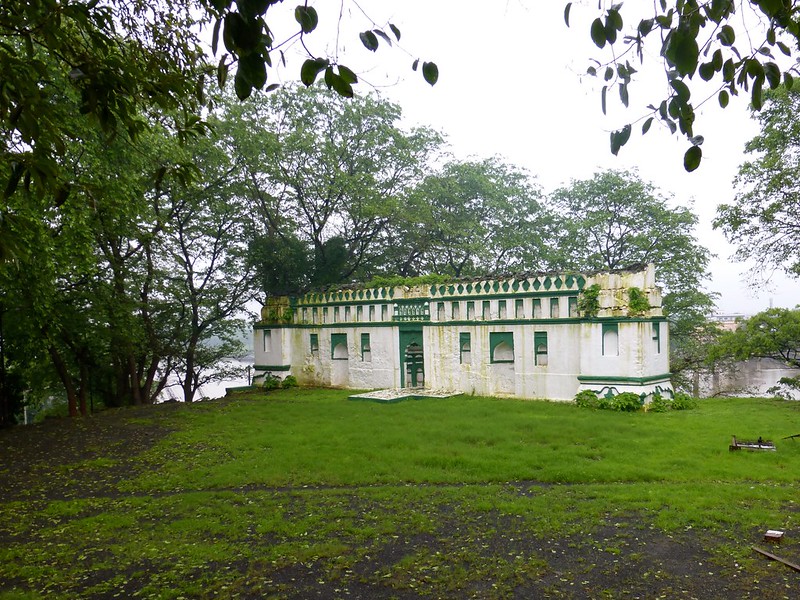 On the upper level of the fort, the second and probably older structure is the prayer wall or idgah. It is located on the western edge which overlooks the river and is about 100 feet above the river and is sixty-four feet long, thirteen high and seven thick. It is now maintained by the Muslim community in the area
On the upper level of the fort, the second and probably older structure is the prayer wall or idgah. It is located on the western edge which overlooks the river and is about 100 feet above the river and is sixty-four feet long, thirteen high and seven thick. It is now maintained by the Muslim community in the area
Kalyan was rocked by Hindu-Muslim riots in 2002 instigated by political motives, after which there has been a permanent posting of a police platoon at the fort. However in recent times the two communities have reconciled their differences, and especially in October when Ramazan and Navratri co-incide, both communities pray together, mediated by the Thane police.
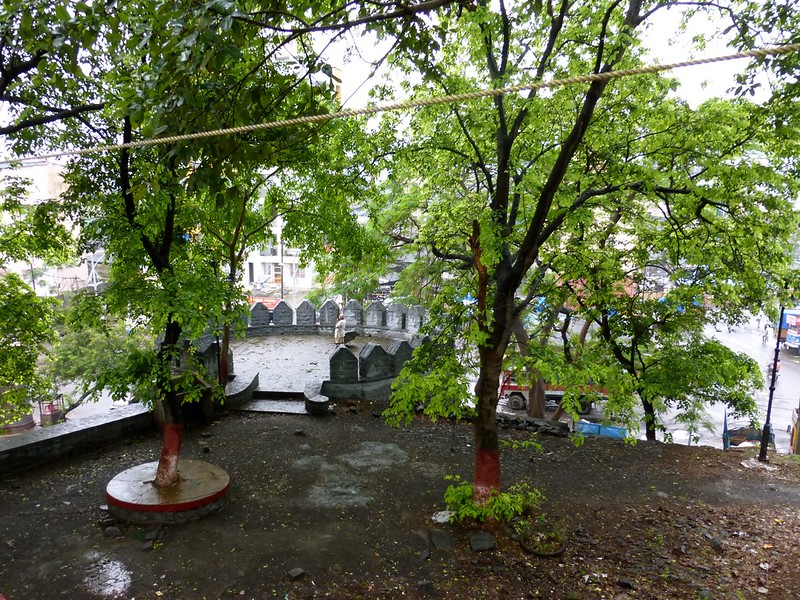 The lower level of the fort is broader, and surrounds the upper level on three sides. From this level, one can access the bastions on the south. This bastion is on the south-east corner
The lower level of the fort is broader, and surrounds the upper level on three sides. From this level, one can access the bastions on the south. This bastion is on the south-east corner
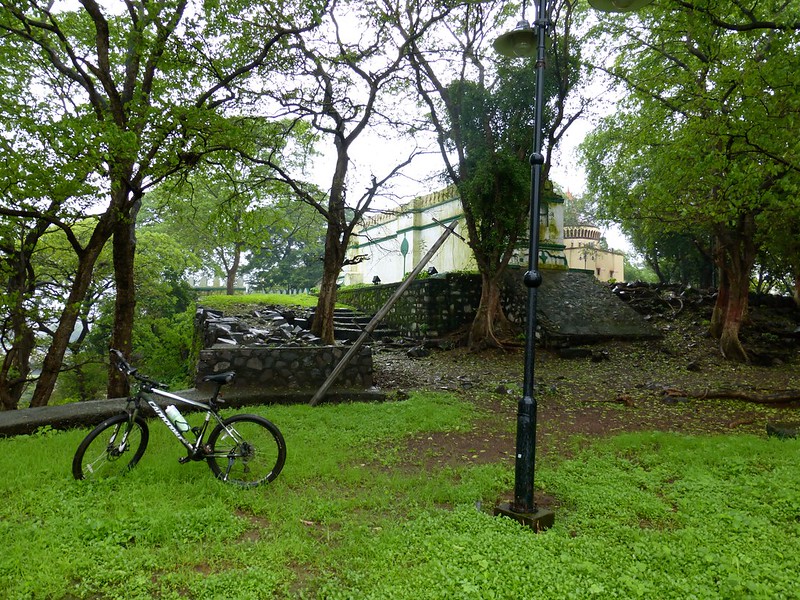 On the south-west end is the second bastion, from where one can see the Idgah. In keeping with the use of the fort by both, the Hindu and the Muslim community, the structures on the eastern end, near the entrance are painted red and white, while this basion on the western end is painted green, matching the paint of the Idgah.
On the south-west end is the second bastion, from where one can see the Idgah. In keeping with the use of the fort by both, the Hindu and the Muslim community, the structures on the eastern end, near the entrance are painted red and white, while this basion on the western end is painted green, matching the paint of the Idgah.
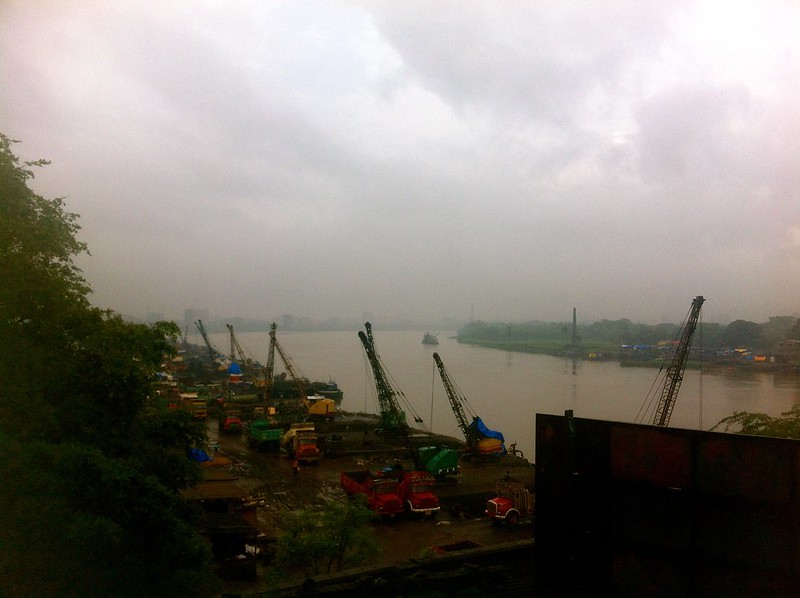 Just then it started raining, with dark clouds blocking out the light. From the bastion on the south west corner, one can clearly see the Ulhas river curving in, and the cranes lining the coast for loading sand into the boats
Just then it started raining, with dark clouds blocking out the light. From the bastion on the south west corner, one can clearly see the Ulhas river curving in, and the cranes lining the coast for loading sand into the boats
 Also visible from the bastion at the south west corner is the old bridge across the river, which is now not motorable
Also visible from the bastion at the south west corner is the old bridge across the river, which is now not motorable
Having spent over an hour and a half at the fort, it was time for me to head back. Instead of heading back the same way I came, I had planned to go along the Kalyan Shilphata road, which is slightly longer but cuts across the Parsik hills.
On the way, I was desperate for a chai, and stopped at a small roadside vendor, only to notice that all I had was a 500 Rupee note in my wallet, and the vendor did not have change.
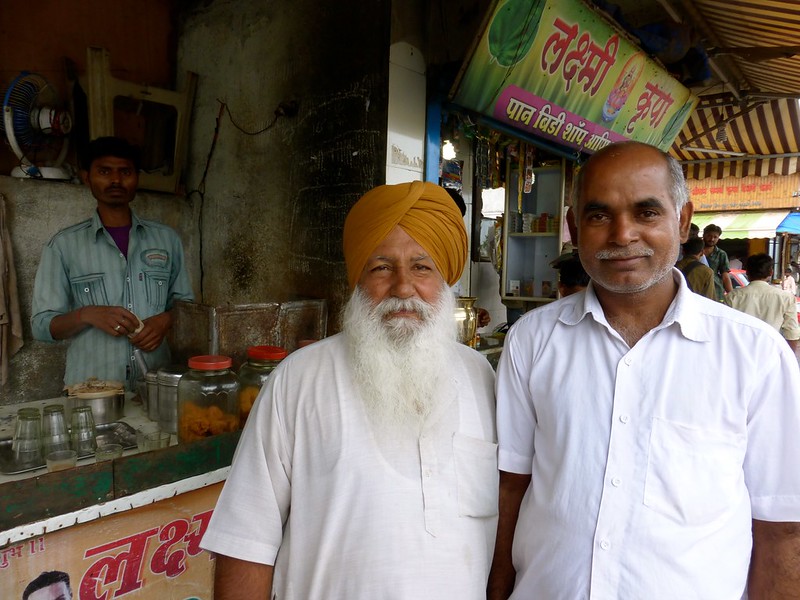 These cab drivers overheard the conversation and immediately offered to pay for my tea. They were curious about my cycle, and were amazed that weird people like me would voluntarily ride a cycle. They were quite aghast at the prices of such cycles and reminisced how they used to cost a few hundred rupees when they used to ride them.
These cab drivers overheard the conversation and immediately offered to pay for my tea. They were curious about my cycle, and were amazed that weird people like me would voluntarily ride a cycle. They were quite aghast at the prices of such cycles and reminisced how they used to cost a few hundred rupees when they used to ride them.
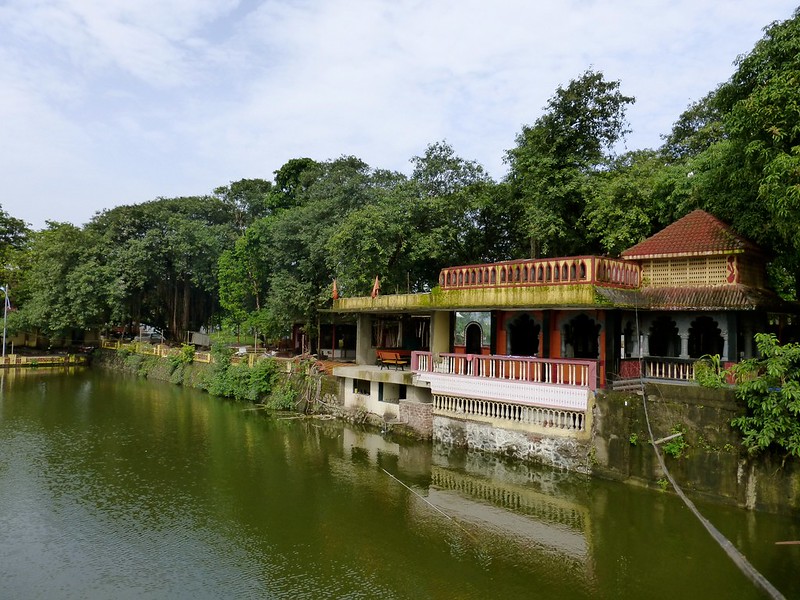 As I rode ahead on the Kalyan Shilphata road, I came across this very old temple called the Khidkaleshwar Mahadev Mandir situated on the banks of the Khiḍkali Lake.
As I rode ahead on the Kalyan Shilphata road, I came across this very old temple called the Khidkaleshwar Mahadev Mandir situated on the banks of the Khiḍkali Lake.
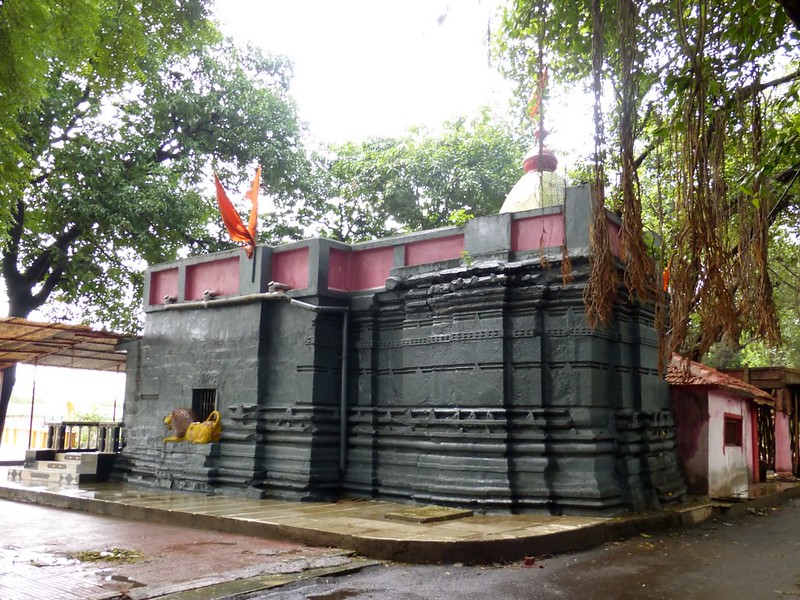 The temple was built around the same time as the Durgadi Fort in the 17th century. The legend about this temple is that the Pandavas visited this place during their exhile in the forests, when Yudhishthira wanted to perform Shiva puja. So the Pandavas built this temple for his puja.
The temple was built around the same time as the Durgadi Fort in the 17th century. The legend about this temple is that the Pandavas visited this place during their exhile in the forests, when Yudhishthira wanted to perform Shiva puja. So the Pandavas built this temple for his puja.
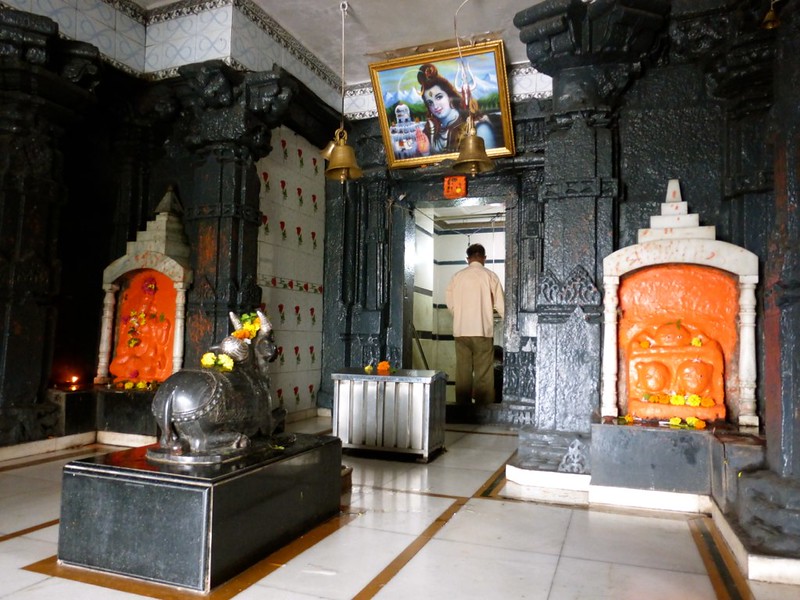 Inside the main temple, in addition to the “swayambhu” – or self manifested Shiva Linga, there are other ancient idols of Ganesha and Hanuman
Inside the main temple, in addition to the “swayambhu” – or self manifested Shiva Linga, there are other ancient idols of Ganesha and Hanuman
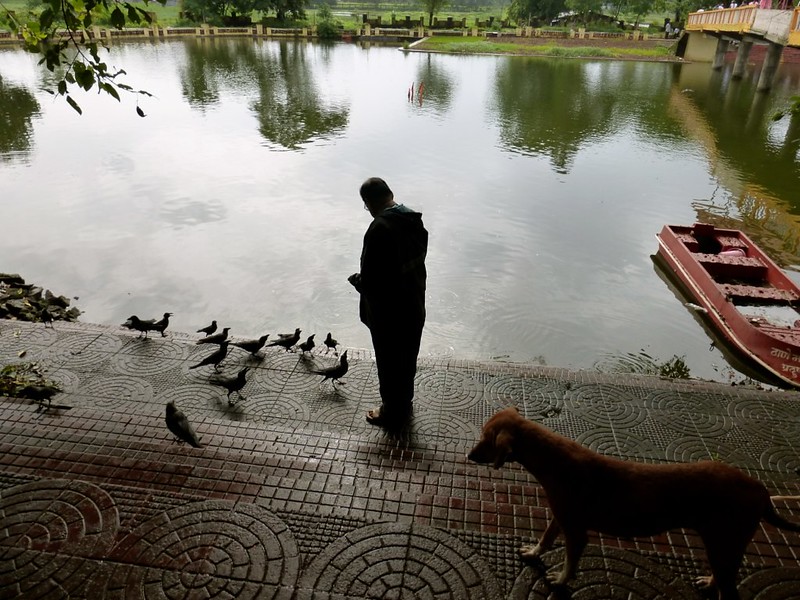 The Khidkali lake is small but peaceful. It is quite well maintained, and is free from weeds and garbage that one often finds in other lakes near temples. This old man stays close by and visits the temple every morning to feed the birds and dogs before he goes in to offer his prayers.
The Khidkali lake is small but peaceful. It is quite well maintained, and is free from weeds and garbage that one often finds in other lakes near temples. This old man stays close by and visits the temple every morning to feed the birds and dogs before he goes in to offer his prayers.
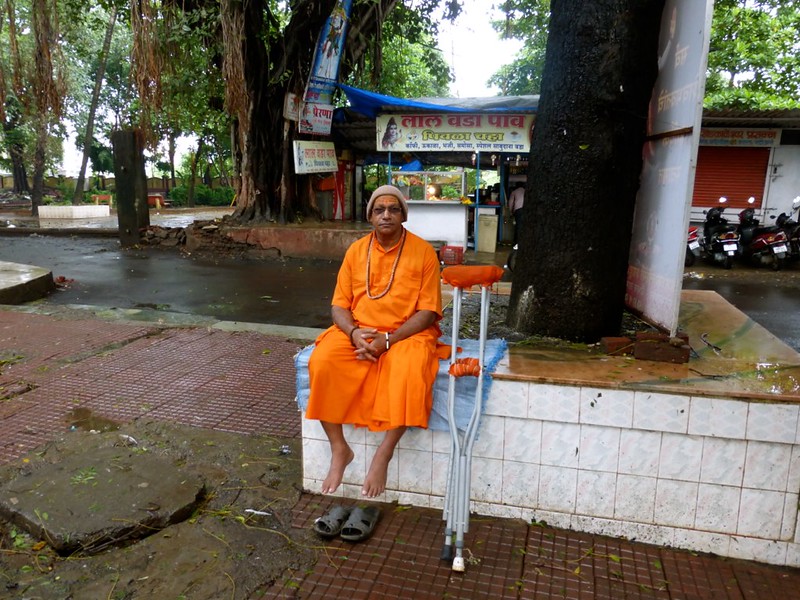 Outside the temple, there are some shops that sell flowers and snacks for visitors. I met this holy man dressed in saffron, who has trouble walking and uses crutches. He is a retired bank clerk, and now spends time in prayer and spends most of his time near this temple for this is where he finds his peace.
Outside the temple, there are some shops that sell flowers and snacks for visitors. I met this holy man dressed in saffron, who has trouble walking and uses crutches. He is a retired bank clerk, and now spends time in prayer and spends most of his time near this temple for this is where he finds his peace.
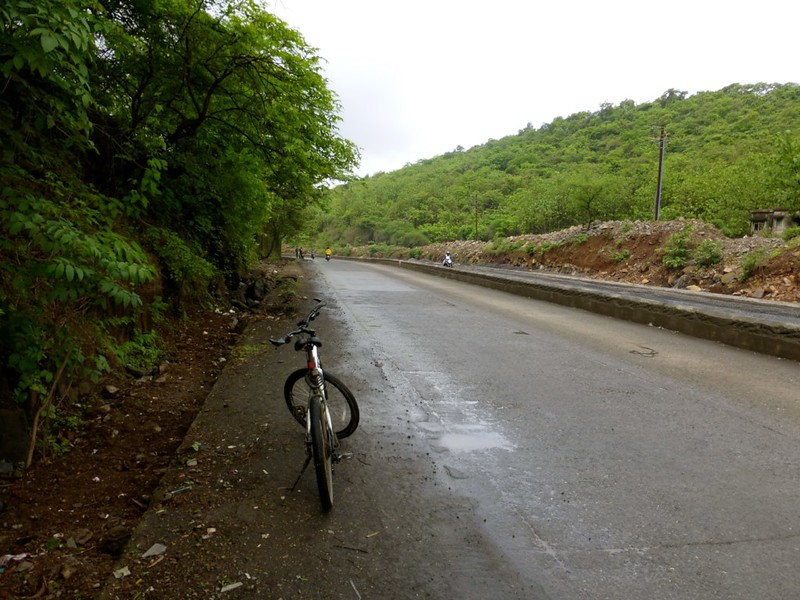 After Dombivali, the Kalyan Shilphata road climbs up into the Parsik hills, where Shilphata – or pass cut through rocks – lies. The hills are covered in thick forests and now in the monsoon the entire forest floor is covered with a green carpet of grass.
After Dombivali, the Kalyan Shilphata road climbs up into the Parsik hills, where Shilphata – or pass cut through rocks – lies. The hills are covered in thick forests and now in the monsoon the entire forest floor is covered with a green carpet of grass.
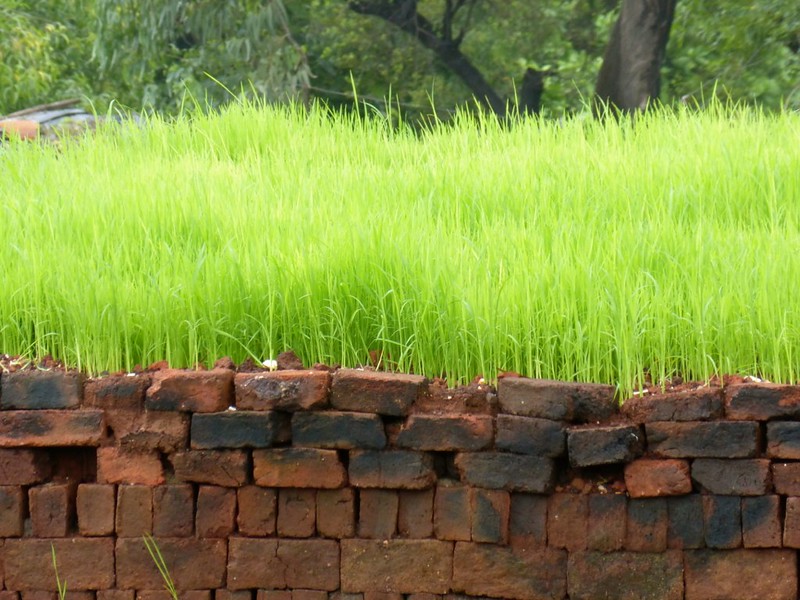 With the burgeoning construction in the area, subsidiary industries like brick kilns and quarries are abounding in the area. With the rains, this stack of bricks has a flourescent layer of green grass on top.
With the burgeoning construction in the area, subsidiary industries like brick kilns and quarries are abounding in the area. With the rains, this stack of bricks has a flourescent layer of green grass on top.
 After climbing over the Parsik hills via Shilphata, I joined the Thane Belapur road at Ghansoli. Thanks to the spurt of industrial development in the area – and most notably Reliance Industries – the road is well maintained and lined with a pleasant green patch of grass with trees.
After climbing over the Parsik hills via Shilphata, I joined the Thane Belapur road at Ghansoli. Thanks to the spurt of industrial development in the area – and most notably Reliance Industries – the road is well maintained and lined with a pleasant green patch of grass with trees.
 At Airoli, there is a nice cycling or walking path all along the bridge that is accessible for pedestrians or cyclists only and provides a great view of the mangroves on both sides
At Airoli, there is a nice cycling or walking path all along the bridge that is accessible for pedestrians or cyclists only and provides a great view of the mangroves on both sides
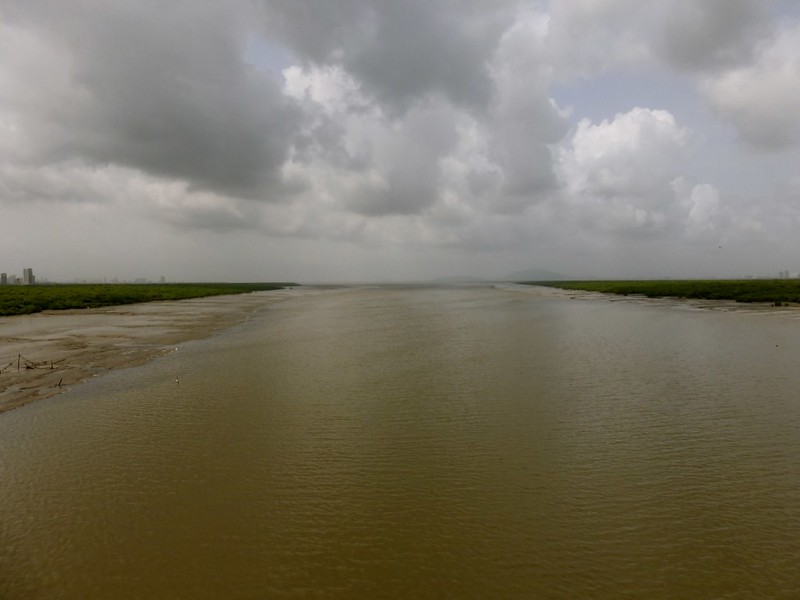 With the monsoon, the water is muddy and all the flamingos that normally feed on the mudflats are gone
With the monsoon, the water is muddy and all the flamingos that normally feed on the mudflats are gone
 This traffic cop on the right is Constable Patil. He saw my camera and told me his story of how he got presented with a similar camera. He said he was posted at the Taj Hotel when there was a terrorist attack in 2008. He had helped rescue some tourists from the hotel, and one of them presented him with a camera.
This traffic cop on the right is Constable Patil. He saw my camera and told me his story of how he got presented with a similar camera. He said he was posted at the Taj Hotel when there was a terrorist attack in 2008. He had helped rescue some tourists from the hotel, and one of them presented him with a camera.
I reached back home at around noon. Thanks to the rains, the weather was really nice and cool. The route turned out to be quite interesting, and I managed to cover a pretty good distance of about 87 km – good exercise to make up for the sedentary work week.
Here’s the route map for your reference:



